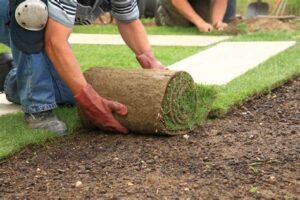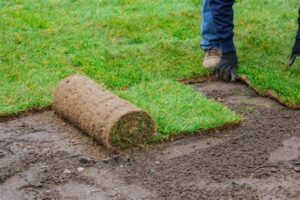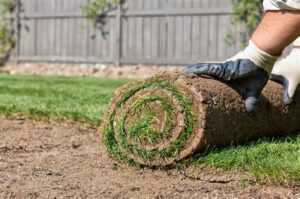When investing in a lush, green lawn, proper care for your newly installed sod is crucial to ensure its survival and health. This guide will walk you through essential practices to promote robust growth after installation. From understanding the best watering techniques to knowing when to mow and how to fend off pesky weeds, each step contributes to a thriving landscape. Additionally, we’ll explore the vital nutrients your sod will need and how sunlight plays a role in its vitality. Whether you’re a seasoned gardener or a novice homeowner, these tips will empower you to create a vibrant and sustainable outdoor space. Get ready to nurture your sod and watch your lawn flourish!
How to Water Your Newly Installed Sod for Optimal Health
Watering your newly installed sod is crucial for promoting strong roots and ensuring healthy growth. Proper irrigation practices will help your sod establish itself successfully. Here are some guidelines on how to water your sod effectively:
- Initial Watering: Water your sod immediately after installation. Ensure that the soil beneath the sod is moist but not saturated. This helps the roots to make contact with the soil and start the establishment process.
- Daily Watering for the First Week: For the first week, water your new sod lightly every day. Aim for about 1 to 1.5 inches of water per week during this initial period, adjusting as necessary for weather conditions.
- Watering Frequency: After the first week, reduce the frequency to every other day. Monitor the moisture level and adjust according to the weather; hot, dry conditions may require more frequent watering.
- Deep Watering: After the initial establishment period, switch to deep watering once or twice a week. This encourages deep root growth by allowing water to penetrate deeper into the soil.
- Time of Day: Water early in the morning or late in the afternoon to minimize evaporation. Avoid watering at night to prevent diseases caused by prolonged moisture on the grass blades.
- Checking Moisture: To ensure that your sod is receiving adequate water, you can check the moisture levels by using a soil probe or digging a small hole. The soil should feel moist a few inches down.
By following these watering tips, you’ll be on the right track in ensuring that your new sod thrives in its environment. Remember, proper watering is a key component of how to care for your sod after installation for optimal health and longevity.
Essential Nutrients to Apply After Sod Installation
After installing your sod, providing the right nutrients is essential for promoting healthy growth. Here’s a guide on what nutrients to apply and why they matter:
When applying fertilizers, it’s essential to follow the manufacturer’s instructions to avoid over-fertilization, which can harm your sod rather than help it. Additionally, consider conducting a soil test to determine specific nutrient needs before application.
Knowing how to properly nourish your newly installed sod with the right essential nutrients can set the stage for a thriving lawn. Regular monitoring and reapplication of fertilizers as needed will contribute to the long-term health and vibrancy of your grass.
How to Mow Sod: Timing and Techniques for Success
Mowing sod is a crucial part of ensuring its healthy growth after installation. Knowing how to mow correctly can make a significant difference in the longevity and appearance of your lawn. Here are essential tips on timing and techniques for successfully mowing your newly installed sod:
Timing Your First Mow
Generally, you should wait until your sod has established itself before mowing for the first time. This typically takes about 2-3 weeks, depending on the type of grass and environmental conditions. Ensure that the grass reaches a height of about 3 inches before your first cut to avoid stressing the roots.
Ideal Mowing Height
For most sod varieties, the ideal mowing height is around 2.5 to 3 inches. To maintain healthy grass, avoid cutting more than one-third of the grass height in a single mowing session. This practice allows the grass to recover and promotes denser growth.
Mowing Techniques
Here are some effective techniques for mowing your sod:
- Use a sharp mower blade: This ensures clean cuts, minimizing damage to the grass.
- Mow when the grass is dry: Wet grass can clump and lead to uneven cutting.
- Alternate mowing patterns: Change your mowing direction each time to avoid soil compaction and promote upright growth.
Regular Maintenance Schedule
Establish a regular mowing schedule to keep your sod healthy. Typically, this could mean mowing once a week during the growing season. Always adjust your schedule according to the growth rate and seasonal changes.
Signs It’s Time to Mow
Look out for visual cues indicating that it’s time to mow:
- When the grass has reached a height of around 3-4 inches.
- When the grass looks shaggy or uneven.
- When you can see seed heads beginning to form.
By following these guidelines on how to mow your sod properly, you’ll promote strong, healthy growth and a lush, vibrant lawn that your family can enjoy for years to come.
Preventing Weeds: How to Protect Your New Sod
After installing sod, one of your primary concerns should be weed control. Weeds can compete with your new grass for essential nutrients, water, and sunlight, potentially jeopardizing its health and growth. Here are some effective strategies on how to prevent weeds from overtaking your sod:
1. Establish a Healthy Lawn
A dense, healthy lawn naturally reduces weed growth. Focus on proper care to strengthen your sod through adequate watering, fertilization, and mowing practices. This creates an environment where grass can outcompete any invading weeds.
2. Use Pre-Emergent Herbicides
Applying a pre-emergent herbicide can effectively prevent weed seeds from germinating. It’s essential to time this application correctly, typically a few weeks after sod installation. Make sure to choose products safe for use on new sod.
3. Regular Mowing
Mowing your sod to the recommended height encourages grass growth while preventing weeds from developing. Avoid scalping the lawn; instead, maintain a regular mowing schedule based on the growth of your sod.
4. Hand Weeding
If you notice any weeds popping up in your new lawn, it’s best to remove them by hand. Pulling weeds out by their roots, especially when they are small, can help minimize their spread and the need for herbicides.
5. Mulching
In areas where sod is not installed, using mulch can help suppress weed growth. Additionally, consider grass clippings from regular mowing; they can act as a natural mulch and provide nutrients to the soil while choking out weeds.
6. Monitor and Adjust Soil pH
Maintaining the proper soil pH can also help prevent weeds. Test your soil and amend it as necessary to keep pH levels ideal for your chosen grass type, which in turn makes it more challenging for weeds to thrive.
7. Proper Irrigation
Watering your sod correctly can minimize weed growth. Overwatering can create a favorable environment for weeds, while underwatering can stress your grass and make it susceptible to weed invasion. Aim for deep watering sessions that encourage robust root growth.
By implementing these strategies, you can effectively manage and reduce weed interference in your new sod. Remember, consistent care is key in establishing a lush, green lawn that is naturally resistant to weeds.
Understanding Sunlight Needs for Healthy Sod Growth
Proper sunlight exposure is crucial for the healthy growth of your newly installed sod. Understanding how much sunlight your sod requires helps you create an ideal environment for establishment and thriving health. Here’s what you need to know about the sunlight requirements for your sod.
Different grass types have varying sunlight needs. Some sod varieties thrive in full sun, while others are more tolerant of shade. It’s essential to know what type of sod you have in order to meet its specific needs.
- Full Sun Sod: Grass types such as Bermuda or Zoysia require at least 6-8 hours of direct sunlight each day. These grasses generally flourish in bright, sunny areas.
- Partial Shade Sod: Varieties like fescue and ryegrass can adapt well to areas that receive 4-6 hours of dappled sunlight each day. Be mindful that too much shade can slow their growth.
- Shade Tolerance: Some grasses, particularly certain fescue types, are designed to thrive in shaded areas, requiring as little as 2-4 hours of sunlight. However, too much shade can lead to thinning and increased vulnerability to disease.
To ensure your sod establishes properly, assess the sunlight conditions in your yard:
- Monitor the light levels throughout the day.
- Consider the time of year, as sunlight patterns change with the seasons.
- Identify obstacles that may be blocking light, such as trees or buildings.
If your sod isn’t getting enough sunlight, consider trimming overhanging branches or relocating other obstructions. Additionally, using reflective surfaces or light-colored mulches can help enhance the amount of sunlight reaching your grass.
Understanding the sunlight needs of your sod is pivotal in caring for it properly. By ensuring it receives the right amount of light, you’ll be on your way to maintaining a healthy, vibrant lawn.
Frequently Asked Questions
What is sod and why is it used in landscaping?
Sod is a layer of grass and soil held together by roots or a fibrous mat. It is used in landscaping to establish a lawn quickly, providing instant greenery and reducing erosion.
When should I water sod after installation?
Sod should be watered immediately after installation. It’s crucial to keep it consistently moist for the first couple of weeks to help the roots establish in the soil.
How often should I water my new sod?
In the first week after installation, water sod daily for about 15-30 minutes to keep the top inch of soil consistently moist. After the roots have established, you can reduce watering to a couple of times a week.
What signs indicate that my sod is not getting enough water?
Signs of underwatering include browning edges, wilting, and a spongy feel when walked on. If the sod is dried out or pulling away from the soil, it likely needs more water.
Is it necessary to fertilize sod after installation?
It’s generally recommended to wait about 4-6 weeks after installation to fertilize your sod. This allows the roots to establish before introducing additional nutrients.
Can I mow my sod right after installation?
No, it’s best to wait at least two weeks after installation before mowing. This allows the sod to root properly without being disturbed.
What is the best way to maintain sod after it has established?
To maintain established sod, follow a regular watering schedule, mow regularly to an appropriate height, aerate the lawn annually, and periodically apply fertilizer to support healthy growth.





